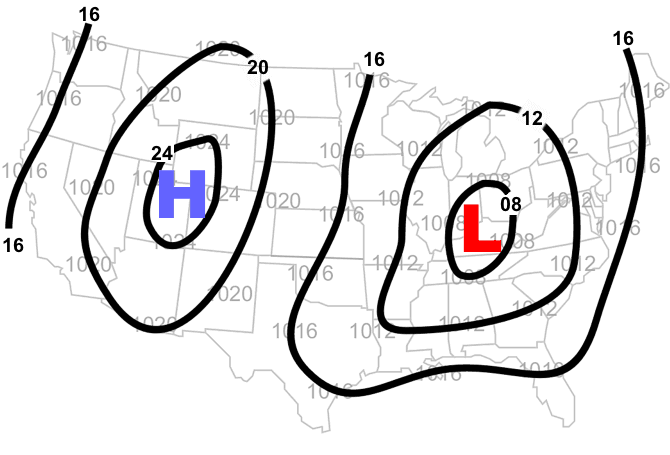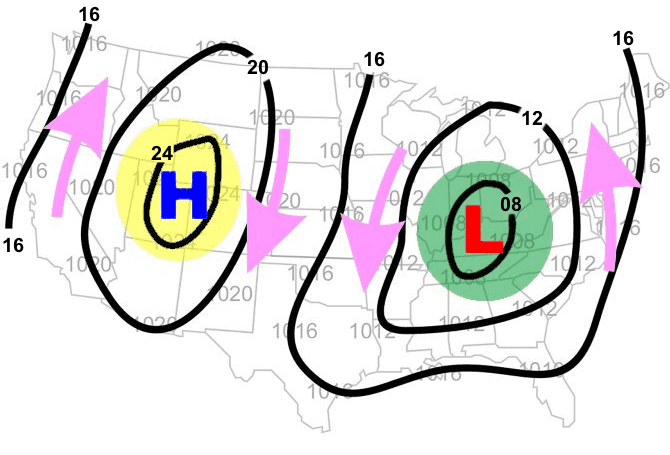
This map shows the sea-level pressures for various locations over the contiguous U.S. The values are in whole millibars.
- Objective
-
Using a black colored pencil, lightly draw lines connecting identical values of sea-level pressure. Remember, these lines, called isobars, do not cross each other. Isobars are usually drawn for every four millibars, using 1000 millibars as the starting point. Therefore, these lines will have values of 1000, 1004, 1008, 1012, 1016, 1020, 1024, etc., or 996, 992, 988, 984, 980, etc.
- Procedure
-
Begin drawing from the 1024 millibars station pressure over Salt Lake City, Utah (highlighted in blue). Draw a line to the next 1024 value located to the northeast (upper right). Without lifting your pencil draw a line to the next 1024 value located to the south and then to the one located southwest, finally returning to the Salt Lake City value. Remember, isobars are smooth lines with few, if any, angles.
The result is an elongated circle, centered approximately over eastern Utah. The line that was drawn represents the 1024 millibar line, and you can expect the pressure to be 1024 millibars everywhere along that line. Repeat the procedure with the next isobar value. Remember, the value between isobars is four millibars. Since there are no 1028 millibar values on the map, then your next line will follow the 1020 millibar reports. Then continue with the remaining values until you have all the reports connected with an isobar.
Label each isobar with the appropriate value. Traditionally, only the last two digits are used for labels. For example, the label on the 1024 mb isobar would be "24". A 1008 mb isobar would be labeled "08". A 992 mb isobar will be labeled "92". These labels can be placed anywhere along the isobar but are typically placed around edges of the map at the end of each line. For closed isobars (lines that connect), a gap is placed in the isobar with the value inserted in the gap.
Your map should look like this.

Learning Lesson: Drawing Conclusions - Isobar Analysis - Analysis
-
Isobars can be used to identify Highs and Lows. The pressure in a High is greater than the surrounding air. The pressure in a Low is lower than the surrounding air.
- Label the center of the high-pressure area with a large blue "H".
- Label the center of the low-pressure area with a large red "L".
Your map should look like this.
Learning Lesson: Drawing Conclusions - Highs and Lows
- Shade in green the state(s) where would you expect to see rain or snow.
- Shade in yellow the state(s) would you expect to see clear skies.
Your map should look like this
Learning Lesson: Drawing Conclusions - Where's the Weather?
In the northern hemisphere, the wind blows clockwise around centers of high pressure. The wind blows counterclockwise around lows.
- Draw arrows around the "H" on your map to indicate the wind direction.
- Draw arrows around the "L" on your map to indicate the wind direction.
Your map should look like this. Learning Lesson: Drawing Conclusions - Where's the Weather?
Learning Lesson: Drawing Conclusions - Where's the Weather?


